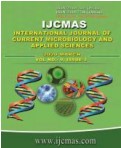


 National Academy of Agricultural Sciences (NAAS)
National Academy of Agricultural Sciences (NAAS)

|
PRINT ISSN : 2319-7692
Online ISSN : 2319-7706 Issues : 12 per year Publisher : Excellent Publishers Email : editorijcmas@gmail.com / submit@ijcmas.com Editor-in-chief: Dr.M.Prakash Index Copernicus ICV 2018: 95.39 NAAS RATING 2020: 5.38 |
A field experiment involving two sowing techniques (broadcasting and line sowing) and five different seed rates (80, 90, 100, 110 and 120 kg/ha) with a total of ten treatments in factorial randomized block design with three replications to compare the energy consumption for different sowing techniques and seed rate of direct seeded rice (Oryza sativa L.) under medium land situation of Manipur was conducted during kharif 2016 at Research Farm of College of Agriculture, Central Agricultural University, Imphal. The result revealed that highest total energy input was observed from broadcasting of seed at the rate of 120 kg/ha (17790 MJ/ha) whereas the lowest total energy input (17135 MJ/ha) from broadcasting of seed at the rate of 80 kg/ha. In contrast highest output energy (217542 MJ/ha), energy efficiency and highest energy productivity of grain (0.35) were obtained from line sowing with seed rate 100 kg/ha. Energy intensity shows that the highest energy consumption was from broadcasting of seed at the rate of 120 kg/ha (3.44 MJ/ha) and the lowest from line sowing with seed rate 100 kg/ha (2.90 MJ/ha).
 |
 |
 |
 |
 |